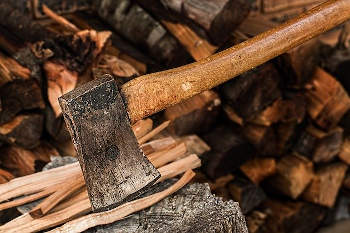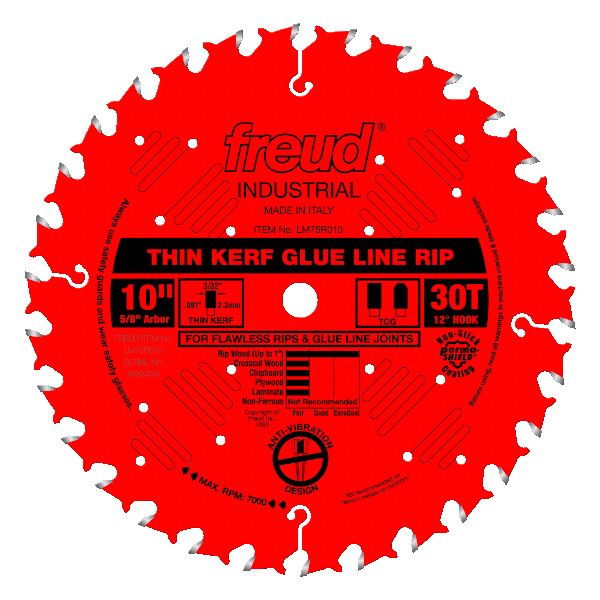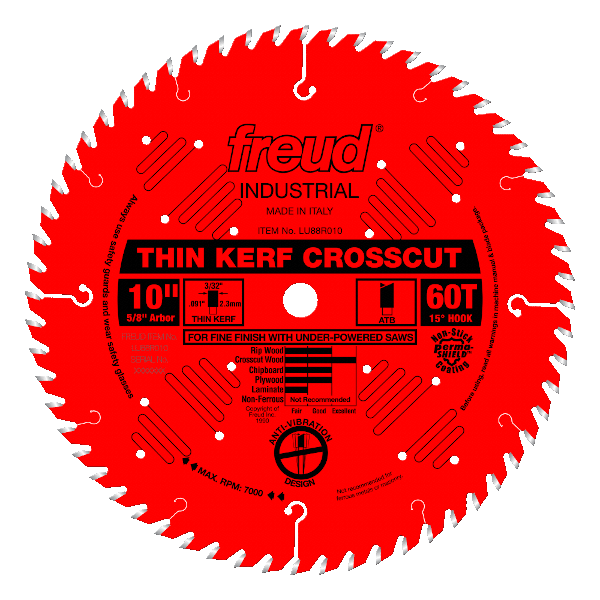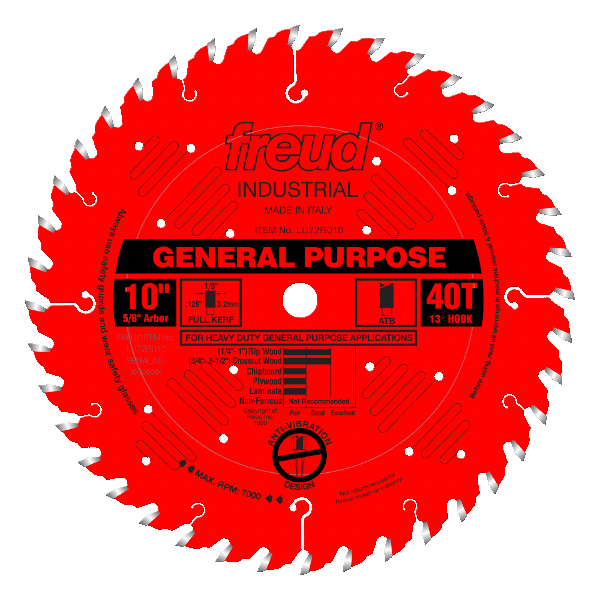Page Contents
Ripping Blades
Ripping, or cutting with the grain is an easy cut. Before there were motorized saws, you had hand saws with 10 or less large teeth for ripping plywood sheets as fast and straight as possible. The saw “rips” the wood apart. It is easier than a crosscut because you are cutting with the grain of the wood.

Picture swinging an axe into the top of a log that is standing up. When you hit the log, the axe is ripping the wood apart through sheer force. But you can hit the log without much force and still split the wood. In this example, you’re splitting the wood with the grain. You can pull off fibers of wood where the axe has split it. It’s possible to pull off a single wood fiber that is the entire length of the wood. That is the idea behind rip cuts- you cut with the grain to minimize effort.

Rip blades are optimized to cut through wood with, or along the grain. Typically used for initial cuts, they clear long fibers of wood where there is less resistance than when cutting across the grain. Using a flat top grind (FTG) tooth pattern, low tooth count (10T- 24T), and a hook angle of at least 20 degrees, a ripping blade cuts through wood along the grain quickly and efficiently with a high feed rate.
The low tooth count of a ripping blade does not pose as much resistance while cutting as a high tooth count blade. But it leaves a much rougher finish on the cut. However, using a ripping blade for cross cuts will lead to an unacceptable amount of tearout. These blades chip away at the wood leaving an unrefined, rough finish. You can clean up a rough-finish rip cut with a crosscut blade. Or you can plane and/or sand it when finishing the workpiece.
The general range on tooth count for ripping blades is 30 teeth on the high end to 10 teeth on the low end. There are some exceptions like an 8 tooth blade, and a 6 tooth blade. But 10T-30T is considered the general range of ripping blades.

There are also ripping blades that will leave the final cut ready for glue application. A 24T FTG ripping blade from a quality manufacturer will usually be able to leave a glue ready edge. These higher tooth count blades leave a smoother finish than their low tooth counterparts.
Another rip blade capable of a glue ready edge would be a 30T triple chip grind (TCG) with a mid-range hook angle of 12-13 degrees. TCG rip blades are manufactured with tight tolerances to focus on leaving a high polished edge on cuts that are glue ready.
TCG high tooth count rip blades are not as suited for ripping thicker materials as 24T and lower FTG blades. Anything over 1-inch thickness would be ripped more effectively with a lower tooth count FTG blade.
Crosscut Blades
Cutting against the grain is much harder than along the grain. In a crosscut, you need to cut through many more fibers than in a rip cut. A crosscut cuts through wood fibers where a rip cut cuts along the fibers to split them apart. In a crosscut, you use a blade with smaller teeth than a ripping blade, but many more of them. Crosscut blades are designed to make clean, finished cuts across the grain of all wood types.

Crosscut blades generate more friction when making cuts because they have more teeth than a rip blade. By having more, but smaller teeth, it takes longer for the blade to cut through the workpiece. The teeth remove a smaller amount of wood when cutting vs. a rip blade. By removing less wood, it leaves a smoother finish on the cut. But it generates more heat through friction than a rip cut. This makes crosscut blades more likely to burn wood when cutting. Making a cut too slow increases the chances of leaving burn marks on the workpiece.

A crosscut blade will generally have between 60-80 teeth on a 10” blade. A 12″ crosscut blade can have up 120+ teeth. The tooth pattern will be ATB or Hi-ATB. Both tooth patterns excel at cutting across wood fibers, leaving a clean, finished cut with little to no tearout.
A Hi-ATB crosscut blade will leave less tearout than an ATB blade with an equal number of teeth. This is because of the steeper bevel angle on the Hi-ATB blade. The steeper the bevel, the cleaner the cut will be. The steep bevel angle causes the tooth to have more of a slicing effect through the wood, ending in much cleaner cuts.
The downside to using a Hi-ATB crosscut blade is that it will wear out faster than an ATB blade. The pointier tipped Hi-ATB blade trades sharper, cleaner cutting for more heat and less cutting efficiency. Although both blades will cut slower than a typical rip blade, the Hi-ATB will cut slower than an ATB, and generate more heat.

For a 10” crosscut blade, 60T-80T is what you’re looking for to get clean cuts and longer blade life. Higher tooth count 10″ blades, up to and over 100T, are more of a niche blade used in high volume workshops. If you’re a hobbyist, those higher tooth count blades are likely not a good option for most projects.
General Purpose Blades
A general purpose blade will never make as clean of a cut as a cross-cut blade, but it might make a cut that’s clean enough for your project. On the other hand, a general purpose blade will leave a much cleaner cut than a rip blade. There are all kinds of trade-offs when using a general purpose blade, but that doesn’t mean that it’s not the right blade for the project. It just might not be the best blade for the job.

General purpose blades fall into the 40T-60T range. They usually feature both an ATB or Hi-ATB tooth. In my experience, a 50T ATBR blade is the sweet spot for general purpose blades. They leave an acceptable finish on most cuts. They tend to be the most forgiving of the 3 types of blades, and provide the all-around best value.
If you’re a perfectionist and you want the best possible performance, you will go with task-specific blades- a ripping blade, and a crosscut blade to start. If you’re not sure exactly what type of blades you need yet, a good general purpose should get the job done to start.
